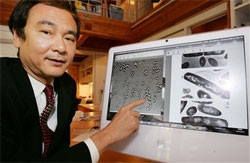Save data in ... DNA of bacteria
Today, data can be stored on floppy disks, computer chips, hard drives and, of course, papers. However, scientists have found a new, smaller storage medium but the stamina and durability are worthy of the championship. It is the bacteria.
The four characters representing the genetic code in DNA have a mechanism that works quite similar to digital data. They combine into different combinations, so that the genetic code can be "interpreted" to create music data, characters, videos and other content.
If the ink could be fuzzy, the computer could fail, the information stored in the bacterial DNA could survive as long as the creature is alive - perhaps up to 1 million years, Professor Masaru Tomita, Keio University team leader said.
 Source: Reuters His team successfully implanted Albert Einstein's famous " E = MC 2 " equation, along with "1905" - the year Eistein published the theory of relativity - into a common bacterial family.
Source: Reuters His team successfully implanted Albert Einstein's famous " E = MC 2 " equation, along with "1905" - the year Eistein published the theory of relativity - into a common bacterial family.
According to Professor Tomita, the "giant" gene code can be stored "where the stone is in the gene" without affecting the normal physiological activity of the body.
However, gene mutations can cause data stored in the DNA to fail. Therefore, the researchers sought to store data at four different points in the bacterial body as a "backup" form.
However, Professor Katsumi Doi of Kyushu University, a bacteriological expert, remains skeptical. " I like this idea, but we need more time to see how practical the application is ."
To translate Einstein's message requires decoding the gene. However, Professor Tomita is a scientist in the form of "very liberal thinking" and he believes that in the distant future, a breakthrough invention will emerge in the brain, allowing humans to decipher a gene. Quick way.
" Storing data in bacteria sounds like a dream. But we are thinking about the future of hundreds of millions of years later, " he said.
Trong Cam
- Scientists use E. coli to store data
- The most toxic and strange forms of bacteria on the planet
- Check out the types of polar bacteria that are beneficial to humans
- Forget sharks, these 5 bacteria also make you
- Bacteria, an inevitable part of ... humanity
- Allway Sync 5.5.8 - Data synchronization is too easy
- Stunned to find bacteria in the brain
- Close up of beautiful deadly bacteria surprised
- World of bacteria - interesting things
- 90% of the world's data has been created over the past 2 years
- The 'amazing' world of bacteria in the human body
- Method of converting magnetic data to optics
 Why do potatoes have eyes?
Why do potatoes have eyes? 'Tragedy' the world's largest carnivorous life: Death becomes ... public toilet
'Tragedy' the world's largest carnivorous life: Death becomes ... public toilet Tomatoes were once considered 'poisonous' for 200 years
Tomatoes were once considered 'poisonous' for 200 years Detecting microscopic parasites on human face
Detecting microscopic parasites on human face